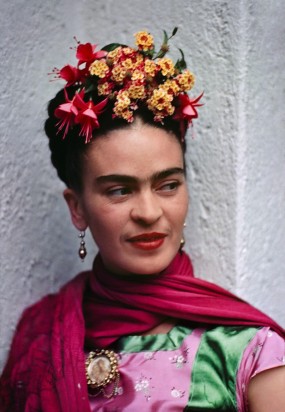Saludos desde California! I’d like to welcome you all to my blog, This Week in Mexican History.
I’m excited to begin this online adventure with a post about a very significant person within the last century of Mexican History — a strong, intelligent woman whose story means a lot to me personally. What I admire most about her is the desire to stay true to herself and to embrace her mestiza identity, while often flouting social convention in her fashion choices, gender/sexuality, and artistic mode of expression.

Of course, I’m referring to Frida Kahlo de Rivera, who was born in Coyoacán, México on July 6, 1907 and also died in her hometown on July 13, 1954, at the age of 47. Her work and personal life have become more renowned over the last 20 years here in the U.S., especially due to the Hollywood blockbuster featuring Salma Hayek (Frida, 2002). Much of her personal story is already well-known, so instead, I would like to pay respect to her significance as an artist by exploring the place and moment in which she lived, which so inspired her creations.

The art of Post-Revolutionary Mexico (~1920s – 1940s) is most often characterized by the murals of “The Big Three/Los Tres Grandes”: Diego Rivera, Davíd Alfaro Siquieros, and José Clemente Orozco. This artwork contained important symbolism, embodying the new social reforms that were called for by the Mexican Revolution: land, labor, and education for all; national unity; idealizing and embracing Mexico’s indigenous past (indigenismo), accompanied by a rejection of the primacy of European culture; and a rise in secularism and intellectualism, which was sometimes associated with the popularity of socialist thought at the time (see: Bolshevik Revolution, 1917).
Beyond Los Tres Grandes, it’s important to recognize the work of Mexican women who were also inspired by Revolutionary values, some who ran in the same intellectual/artistic circles as those named above. Frida Kahlo was one of these women, along with Tina Modotti, Lola Cueto, Rosario Cabrera, Chabela Villaseñor, and Nahui Olin, whom art historian Tatiana Flores characterizes as “Strategic Modernists.” Flores defines this as:
“Women avant-garde artists of post-revolutionary Mexico who engaged with modernist thought and prevailing modes of visual production… All rejected academic traditions and pondered through visual means what should be the purpose of Mexican art in the postrevolutionary moment. Their strategies included critiquing dominant avant-garde models, experimenting with diverse media that challenged the parameters of high art, employing pedagogy and activism as a means to effect social and cultural changes, and asserting the relevance of art that engaged personal experience. Stylistically heterogeneous, their work redefines the role of art and the artist in the post-revolutionary period.”
Flores, Tatiana. “Strategic Modernists: Women Artists in Post-Revolutionary Mexico.” Woman’s Art Journal, Fall-Winter 2008, 29, no. 2 (2008): 12.
We can easily see, by looking at the repertoire of Kahlo’s artwork, how intimately she portrayed her own personal experiences, by showcasing herself as the subject of many of her paintings. She used aspects of Mexican folk art (indigenous aesthetics) and surrealism to depict herself overcoming physical and emotional suffering or also living everyday life. Kahlo challenged gender roles by depicting herself wearing a man’s suit with short hair, for example, and by depicting herself as a woman surrounded by dreamlike, sometimes gory imagery, as opposed to looking pristine and conventionally beautiful.
Kahlo painted what she knew, her immediate environment including herself, her thoughts, plants and animals, close friends. Although she’s now become part of popular Latino culture here in the U.S. (I have a great pair of socks with her likeness on them), I’m using this opportunity to remember her for her contributions to the art world. Kahlo is both representative of the Post-Revolutionary moment in Mexico and its values, while simultaneously challenging the status quo in regard to gender and visual expression.
Thanks for sharing this moment of reflection for Frida during this week, that of her birth and death.
[A huge shout-out to my former professor, mentor, and friend Dr. Miriam Riggs for the resources and intellectual inspiration for this article. Thank you!]
Recomendaciones
Visitar : If you’re in Mexico City, make sure to visit Frida & Diego’s home, La Casa Azul aka Museo Frida Kahlo. Also check out Rivera’s awesome collection of Pre-Hispanic art @ Museo Anahuacalli.
Ver : For a general, North American overview of Frida’s life, watch the film Frida (2002)
YouTube has some cool Frida videos – including this one from Univision about the newest exhibition at Museo Frida Kahlo, which showcases fashions from her closet which has remained under wraps for 58 years, now being made public.
Take a brief tour of Coyoacán , including the Museum, from a Mexican vlogger (in Spanish, can use subtitles).
No longer running in So Cal, now at the Cincinnati Opera, try to catch the opera based on our favorite lady, aptly titled Frida.
Know any good books, documentaries, films, exhibitions, etc. related to Frida Kahlo? I welcome your suggestions!!
